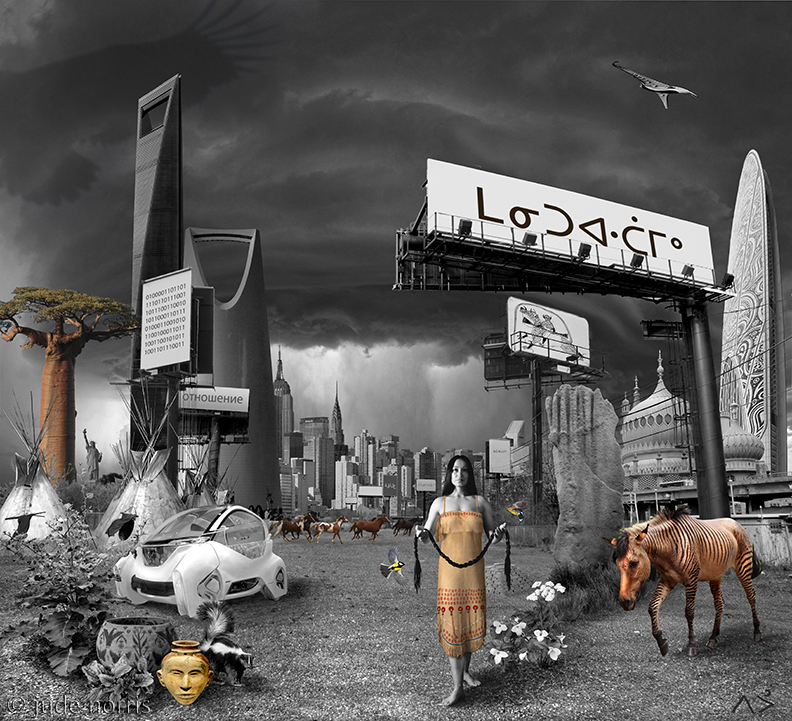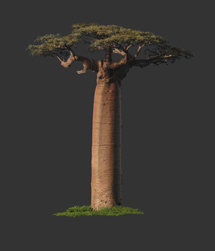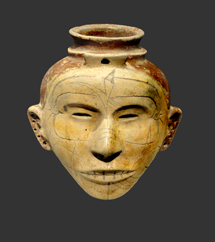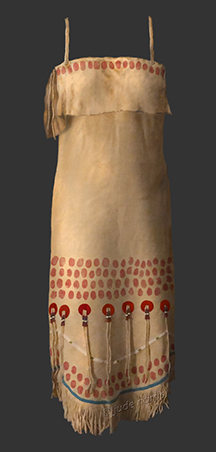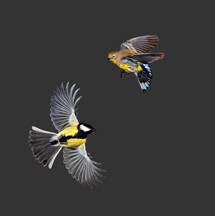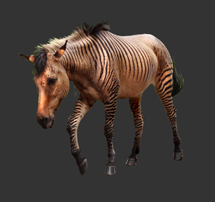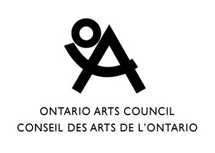PLEASE CLICK ON IMAGE TO ENLARGE & VIEW IN LIGHTBOX
INFORMATION ON LANDSCAPE ELEMENTS:
foreground landscape
Liberty Village Toronto ON, Canada
background cityscape
Manhattan NY, USA
objects, animals, people & beings
Jude Norris / Bebonkwe (the artist) wearing a
digital composite Plains Cree side fold style deer hide dress
and holding her 2002 sculpture ‘rubber braid 1’
physical dress (2007): brain-tanned deer hide, glass seed beads, glass trade beads, metal beads, thread
digital dress (2022): adorned with the artist’s thumbprints & digital composite rosettes
rubber braid 1 bicycle inner tube rubber 64 x 2 x 3/4” 2002
This dress is a digitally sewn together from an image of the deer-tail style hide dress created by the artist for the 2007 installation piece Sohkatisiw Iskwewasakay (Strong Woman Dress) installation, part of the Between the Lines series.
This digital alteration transforms the dress into an older, pre-contact style of dress known as the side fold dress. These sleeveless dresses were commonly worn by the women in a number of Plains First Nations. They had separate, detachable sleeves that could be removed in warm weather. Since they were common before the widespread embrace and use of European glass seeds beads, they were usually adorned with quillwork, and often also painted with pigment.
This dress is a contemporary version of this dress style, incorporating the hemline of the later deer-tail style dress, adorned with glass and metal beads and (digitally adorned) painted thumbprints and felt rosettes. The red rosettes and prints are related to Thunder Beings and thunderstorms. The thumbprints are also an acknowledgement of the many missing and murdered Native women on Turtle Island (currently approximately 10,000 across the territories now known as Canada and the US). Imbued with the energy of all the powerful, talented, resourceful and loving First Nations women on the Sohkatisiw Iskwewasakay, this dress honors the central position and deep respect of women and the feminine in First Nations cultures and acknowledges the connection between that power and the widespread colonial harms perpetrated against our women and all things feminine.
In this landscape I exist in multiple times and locations a once.
I consider this a ‘self-portrait as more of myself’, in which I’m more multi-dimensional,
and more deeply, consciously and constantly aniskomiw (connected) with my environment and All My Relations than when in the physical world and body – except of course when I’m creating art.
The double ended braid I’m holding out is part of my braided sculpture series. This braid is made from used bicycle inner tubes, a material I began using in the 1990’s, meticulously cut into thin strips and then braided. Many of my artworks contain painstaking, arduous and/or repetitive activities in their creation process, which are connected with ritual and entering meditative or trance states. This photo was taken in 2002, when another artist shot images of me holding some of my sculptures, in conjunction with posing for her as a life model. This image exemplifies the latent, inherent, intentional performative qualities of these malleable and moveable sculptures.
The higher self represented in this artwork relates to the state of being that is embodied by the Feathered Serpent (which you will see and find out more about in another one of these landscapes, if you haven’t already) a sacred being who is also present in Plains Cree, Okanagan and other Indigenous cultures. So this is also a celebration of how as artists we are gifted with the ability to regularly connect with the Spirit world and the inherent creative energy of the Great Mystery in a direct way.
I hold out my artwork to the viewer in honor of these creative gifts and with the recognition and understanding that they are what I have to offer my people, my various communities, and the world at large.
Click here for more info about the artist.
Warblers (birds in flight)
Yellow warbler (left) & yellow-rumped warbler (right)
Yellow warblers live in woodlands across Turtle Island.
They particularly like willow trees, as do I,
and given that this tree is so important to our ceremonies,
I feel it makes them special.
Also, they often fly in circular patterns when mating (as do I lol).
Yellow-rumped warblers prefer the forest edge or open forest homes,
and some also live in residential areas.
They catch insects in flight & eat berries in winter.
Their territory also ranges across Turtle Island,
and they have coloration differences in different locations.
Thunderbird or Condor Spirit wing (upper left, in sky)
Thunderbird
Reverence for the Thunderbird Spirit is common to many Tribes across Turtle Island. Thunder storms are understood by American Indian people to be powerful spirit beings. The sounds of the thunder is the sound of their voices and lightning flashes from their eyes as they come to clean the land of negative energy. The Thunderbird is a life giving force, as it also brings water necessary for life and growth.
The Thunder Beings have appeared in various ways in visions, ceremony and art. The giant Thunderbird is one form ‘the Thunders’ commonly take. It is often represented by an eagle or a condor. I chose a condor’s wing to represent the Thunderbird in the Liberty Village sky. The majestic condor has one of the largest wingspans of any bird. Like the eagle, it is highly respected in First Nations culture, and is part of a spiritual prophesy (see below).
Condor
Condor is the name used for vultures found in North America. There are two kinds of condors, the Andean Condor in South America and the California Condor who’s territory is currently restricted to western coastal mountains of the United States and Mexico.
Both species of condor have experienced serious population decline. In 1982 California condors had almost become extinct, with on 23 left in the world. Recovery efforts have been helping, but their numbers are still dangerously low. There are now 405 California condors, with 226 of them living in the wild. The Andean Condor is faring a little better in actual population, but it’s numbers have been decreasing. It is currently on the ‘near threatened’ list.
Condor and Eagle Prophecy
The ancient prophesy of the Condor and the Eagle originated amongst South American Indigenous Nations. It has been deeply important to such people as the Andean Quechua, Incas, New Mexican Hopi, Guatemalan, Honduran and Mexican Mayan, Ecuadorian Shuar, and others for hundreds of years. It has also been shared with, know and accepted by Indigenous Nations all across Turtle Island (the Americas) for just as long. More recently it has become the first truly international Indigenous prophecy widely embraced by both Native and European-descended peoples, and is now familiar across the world.
For more info on the Condor and Eagle Prophecy hover here
Chickasaw human head effigy jar
circa 1350 – 1550 AD
Collection of the Nelson Atkins Museum of Art, .
From the late Mississippian culture, Arkansaw.
Bird & butterfly basket by Lucy Parker Telles
Collection of the National Museum of the American Indian.
Lucy Parker Telles (ca. 1870/1885–1955/6) Mono Lake Paiute – Kucadikadi (Northern Paiute) and Southern Sierra Miwok (Yosemite Miwok). Basket weaver active in the Yosemite Valley region, California.
Striped Skunk
Skunk territory includes most of the North American continent north of Mexico, and they can be found living in a number of habitats, including woodlands, grasslands, agricultural lands and urban areas.
Running horses Similkameen Rezervation, BC, Canada
Horses on one of the artist’s home areas.
Standing stone Isle of Arran, Scotland
Circa 1800 to 1600 BC
One of a number of stones at Machrie Moor, on the west side of the isle (where I once travelled by bicycle from Glasgow specifically to visit these stones).
Zorse Africa
Hybrid cross between a horse and a zebra
Pile of Gold Bullion (right background, behind Jude)
I’ve been incorporating gold it into my work and/or creating golden artworks for many years.
Across cultures, sold is the most valued of earth’s minerals. Is is physically indestructible, dense, consistent, very malleable and conductive.It is magically potent and spiritually healing and transformative.
You will find more in depth information about gold in another of these landscapes.
plant medicine & trees
Burdock
Burdock is native to Europe and Asia, though it now grows throughout Turtle Island. It is a a diuretic and a powerful antioxidant and can be used medicinally to purify the blood, treat skin issues, rheumatism, gout and help prevent certain kinds of cancer.
It is also used a stomach tonic and an aphrodisiac.
Plantain
There are over 200 species of plantain and it grows widely across Turtle Island. Due to its anti-inflammatory, anti-bacterial, anti-fungal, anti-oxidant, and anti-ulcerative properties, it has many healing applications. It can be used to draw out infection, to calm insect bites and stings, and to heal wounds and burns.
Plantain is also good for treating lung issues such as bronchitis and coughs.
Broadleaf plantain, which is originally from Europe, has been used successfully to treat cancer.
Baobab tree (left skyline) Africa
Baobab trees are an ancient species. They predate both the emergence of humans and the splitting of the continents over 200 million years ago. They are found in Africa, Madagascar, Arabia and Australia. They may reach up to 100 feet in height and be 35 feet wide.
The fruit from the tree is a food source for Indigenous peoples in the various places these trees grow.
Due to their ability to store water and grow in extremely harsh and arid climates, they are a symbol of positivity, growth and life in challenging times.
Trillium plants (flowering)
Trillium plants are Indigenous to Turtle Island. The leaves are edible and tasty, and the flowers and roots have numerous medicinal properties. Native people understand this to be a sacred female herb.
It has strong spiritual symbolism, as the three petals of the flower can be seen to represent the balancing of mind, body and spirit.
Yarrow (flowering)
There are over 100 species of yarrow, and this plant also has numerous medicinal properties that have been in use for thousands of years. It may be used to aid in healing wounds and connective tissue injuries.
It also helps with various stomach and digestive issues.
An elder also shared with me that it can help heal cancer.
In addition, it can be used in the treatment of depression, anxiety and overall brain health.
billboard words and images
Cree inspiration billboard (right foreground)
Says ‘She speaks inspired by Spirit’
in Plains Cree language syllabics.
Connectedness code billboard (left mid-ground)
Says ‘connectedness’ in binary code.
отношение Russian respect billboard
Says ‘respect’ in Russian.
Definition: attitude, ratio, relation, relationship, treatment, respect
Arabic respect billboard (dark, right skyline) علاقة
Says ‘respect’ in Arabic.
Definition: relationship, relation, connection, link, relevance, respect
Cree abundance billboard (right skyline)
Written in Plains Cree language syllabics.
Definition: The act of being plentiful or in abundance
Cree Beauty billboard (right skyline)
Says ‘It is Beautiful’
in Plains Cree language syllabics
Thunder-Being ledger drawing billboard
drawing c 1880 Thunder deity on his masked horse, from the ledger book of Black Hawk (Medicine Man of the Sans Arc Lakota)
transportation
Honda Urban Micro Commuter – concept design (left foreground)
Battery-powered, customizable concept car featuring smart-phone like interactivity.
Lockheed-Stratoliner – concept design (upper right sky)
Designer: William Brown.
Long range hydrogen-powered jet with zero emissions, with wings based on the form of the far-flying Bar Tailed Godwit bird.
Indigenous architecture
First Nations tipis
Traditional portable hide houses of numerous Indigenous Nations of North America.
Tipis are a wonderful example of low-impact yet technologically advanced ‘soft architecture’.
skyline architecture and objects
Statue of Liberty Ellis Island, NYC
Artist: Frédéric Auguste Bartholdi.
151 ft (46 m) Ground to torch: 305 ft (93 me). Completed 1886
Shanghai Financial Centre Tower Shanghai, China
1,614.2 ft. (492 m). Completed 2008.
Architect: Kohn Pedersen Fox
Kingdom Tower Riyadh, Saudi Arabia
992 ft (302.3 m). Completed 2002.
Architect: Ellerbe Becket, Omrania and Associates
Manhattan skyline NYC, USA
Brighton Palace Brighton, UK
Completed 1823.
Primary designer: John Nash.
(I lived in Brighton for 2 years and walked by this building many times. I also worked in the theatre there briefly as a yound artist, as a snack vendor)
Namaste Tower Mumbai, India
Architect; WS Atkins Plc. 984 ft (300 m). Planned building due to open July 2015.
When you have finished your journey through the Response-Hive City,
I invite you to read the project description.
This artwork is available for sale as a limited edition, archival-quality inkjet print.
Please email Jude@JudeNorris.com for information & pricing.
